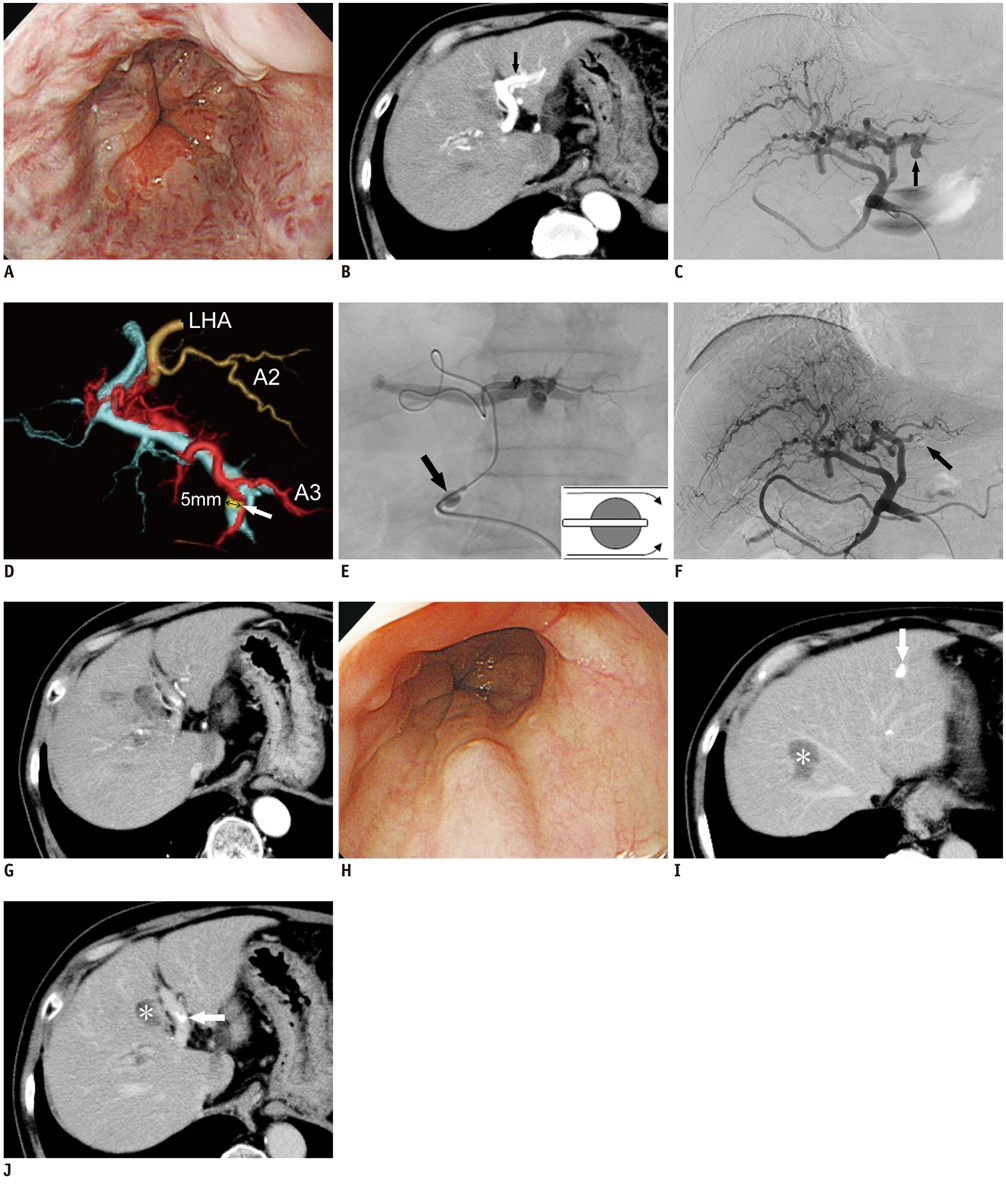Korean J Radiol.
2014 Apr;15(2):250-253. 10.3348/kjr.2014.15.2.250.
N-Butyl Cyanoacrylate Embolization with Blood Flow Control of an Arterioportal Shunt That Developed after Radiofrequency Ablation of Hepatocellular Carcinoma
- Affiliations
-
- 1Department of Radiology, Wakayama Medical University, Wakayama 641-8510, Japan. sonomura@wakayama-med.ac.jp
- 2Department of Internal Medicine, Wakayama Medical University, Wakayama 641-8510, Japan.
- KMID: 1705580
- DOI: http://doi.org/10.3348/kjr.2014.15.2.250
Abstract
- We present a case of a patient with rapid deterioration of esophageal varices caused by portal hypertension accompanied by a large arterioportal shunt that developed after radiofrequency ablation of hepatocellular carcinoma. We used n-butyl cyanoacrylate (NBCA) as an embolic material to achieve pinpoint embolization of the shunt, because the microcatheter tip was 2 cm away from the shunt site. Under hepatic arterial flow control using a balloon catheter, the arterioportal shunt was successfully embolized with NBCA, which caused an improvement in the esophageal varices.
Keyword
MeSH Terms
-
Aged
Arteriovenous Fistula/etiology/radiography/*therapy
Carcinoma, Hepatocellular/*surgery
Catheter Ablation/*adverse effects
Embolization, Therapeutic/*methods
Enbucrilate/*therapeutic use
Esophageal and Gastric Varices/etiology/*therapy
Hepatic Artery/*abnormalities/radiography
Humans
Liver Neoplasms/*surgery
Male
Portal Vein/*abnormalities/radiography
Enbucrilate
Figure
Reference
-
1. Livraghi T, Solbiati L, Meloni MF, Gazelle GS, Halpern EF, Goldberg SN. Treatment of focal liver tumors with percutaneous radio-frequency ablation: complications encountered in a multicenter study. Radiology. 2003; 226:441–451.2. Lazaridis KN, Kamath PS. Images in hepatology. Arterioportal fistula causing recurrent variceal bleeding. J Hepatol. 1998; 29:142.3. Kerlan RK Jr, Bank WO, Hoddick WK, Pogany AC, Sollenberger RD. Occlusion of a hepatic artery to portal vein fistula with bucrylate. Cardiovasc Intervent Radiol. 1983; 6:138–140.4. Kanematsu M, Kondo H, Goshima S, Tsuge Y, Watanabe H, Moriyama N. Giant high-flow type pulmonary arteriovenous malformation: coil embolization with flow control by balloon occlusion and an anchored detachable coil. Korean J Radiol. 2012; 13:111–114.5. Idezuki Y. Japanese Society for Portal Hypertension. General rules for recording endoscopic findings of esophagogastric varices (1991). World J Surg. 1995; 19:420–422. discussion 423.6. Strodel WE, Eckhauser FE, Lemmer JH, Whitehouse WM Jr, Williams DM. Presentation and perioperative management of arterioportal fistulas. Arch Surg. 1987; 122:563–571.7. Chen Q, Tack C, Morcos M, Ruggiero M, Schlossberg P, Fogel J, et al. Embolotherapy of an arterioportal fistula. Cardiovasc Intervent Radiol. 2007; 30:1047–1051.8. Applbaum YN, Renner JW. Steel coil embolization of hepatoportal fistulae. Cardiovasc Intervent Radiol. 1987; 10:75–79.9. Orons PD, Zajko AB, Jungrels CA. Arterioportal fistula causing portal hypertension and variceal bleeding: treatment with a detachable balloon. J Vasc Interv Radiol. 1994; 5:373–376.10. Pollak JS, White RI Jr. The use of cyanoacrylate adhesives in peripheral embolization. J Vasc Interv Radiol. 2001; 12:907–913.
- Full Text Links
- Actions
-
Cited
- CITED
-
- Close
- Share
- Similar articles
-
- Gallbladder Fistula Treated with N-Butyl-2-Cyanoacrylate after Radiofrequency Ablation in a Hepatocellular Carcinoma Patient: a Case Report
- Abscesso-Colonic Fistula Following Radiofrequency Ablation Therapy for Hepatocellular Carcinoma; A Case Successfully Treated with Histoacryl Embolization
- Embolization of Seve re Arterioportal Shunts in the Patients with Hepatocellular Carcinoma: Safety and Influence on Patient Survival
- Intrahepatic Arterioportal Shunt:A Mechanism of Hypovascular Hepatocellular Carcinoma
- Multiple Cerebral Infarction after Injection of N-Butyl-2-Cyanoacrylate for Gastric Variceal Bleeding


